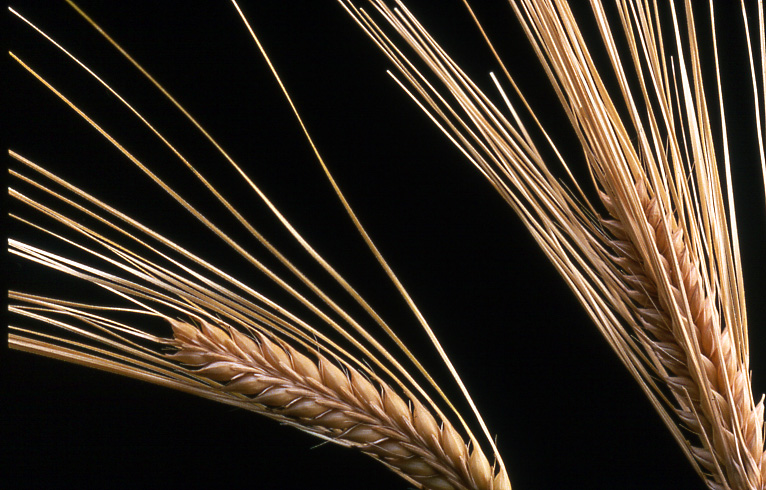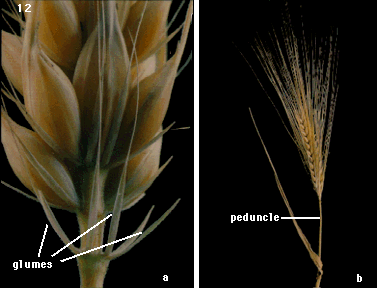Barley
Last updated on
February 23, 2014
Note: This information was developed from lecture notes for the Farm and Industry
Short Course at the University of Wisconsin.

ADAPTATION
Barley is widely grown in many climates of the world due to its WIDE ADAPTATION
COLD TOLERANCE
- Spring barley has excellent cold tolerance
- Spring types are grown at HIGHER ALTITUDES than any other cereal
- Grown in upper plateaus of Tibet - Spring barley is grown farther north than any
other cereal
- Some grown within the ARCTIC CIRCLE
EARLY RIPENING
- Some barley varieties ripen earlier than any other cereal
- Barleys in the ARTIC CIRCLE ripen in 60-70 days
ALKALINE SOILS
- Barley has excellent tolerance to alkaline (basic) soils, but has poor tolerance
to acidic soils Basic soils: BARLEY>WHEAT>TRITICALE>OATS>RYE
DROUGHT TOLERANCE
- Barley has very good drought tolerance
- Known for drought tolerance in the western USA & CANADA
- Grown in arid climates of the Sahara Desert
HEAT TOLERANCE
- Barley has good HEAT TOLERANCE, but the heat must be DRY heat
- Barley does not do well in humid areas - too many disease problems
- Overall, barley is a crop that is best adapted to COOLER, DRIER areas
- Best conditions for growth
- Loam soils with medium to medium high fertility and a long, cool spring with relatively
dry conditions after heading
ACREAGE AND PRODUCTION
USA - Barley is grown primarily in the NORTHERN GREAT PLAINS & NORTHWEST
- Leading states ND, MINN, SD, MONT, IDA, WASH, CA
- Some winter barley is grown in the SOUTHERN GREAT PLAINS (Nebr, OK) and in SOUTHEASTERN
states (GA, MD, NC, etc)
- Wisconsin was a leading barley state from the late 1800's until the early 1940's
- Principal barley area has moved west of the Mississippi River
- Better quality barley produced in western states
WORLD - Barley is widely grown in many countries
- Russia - 20% of world's acreage
- ASIA - China, Turkey and India have large acreages
- EUROPE - Many countries have large acreages
- NORTH AMERICA - Western US & Western CANADA
- NORTH AFRICA - Several countries (Morocco, Algeria, and Ethiopia) have sizable acreages
- AUSTRALIA - barley is popular in some areas
- Barley is not widely grown in South America
SPECIES
- Cultivated barleys: (Tough rachis) Diploids
- Six-rowed: Hordeum vulgare L.
- Two-rowed: Hordeum vulgare L.
- Wild barleys: (Brittle rachis) Diploid: Hordeum spontaneum L.
- Tetraploid: Hordeum bulbosum L. Hordeum jubatum L. - perennial - squirrel tail barley
PLANT DESCRIPTION
VEGETATIVE
- Barley is similar to the other small grains
- Fibrous roots
- Parallel leaf veination
- Alternate leaves - largest auricles
- Culms - 6 or 7 nodes & internodes
- Tillers more than wheat, oats, & rye
- Slightly larger leaf area than other spring grains
INFLORESENCE - SPIKE

- Central axis of spike = rachis
- Six-rowed barley - 3 spikelets/rachis node
- Two-rowed barley - 1 spikelet/rachis node
- Two-rowed & six-rowed varieties have similar grain yield potential
- Six-rowed - More kernels/spike - Smaller kernels - Less tillering
- Two-rowed - opposite of above
- Cultivated barleys = 1 floret/spikelet
- Glumes are small
- Awns = extension of lemma - Rough, smooth, & semismooth. Most varieties have
long awns
- Rachilla = Central axis of a spikelet - Used in classification in barley
Pollination
- Begins in the middle of the spike & proceeds up and down
- Takes 2-3 days for pollination to be completed in a spike
- In the field, pollination often occurs before the spike has emerged from the boot
(cleistagamous)
CULTURE AND MANAGEMENT
Similar to oats and sp wheat, but a higher level of management is required if growers
want to sell their barley for malting. Not much Wisconsin barley is malted because
kernel quality of WI barley is not as good as kernel quality of western barley.
In WI, frequent morning dews discolor kernels during ripening. Discolored kernels
have higher fungal activity and are more difficult to handle during malting and
brewing
Barley growers need to manage N APPLICATION very carefully
HIGH N CAN LEAD TO:
- Lodging
- Reduced grain yield and quality Reduced harvest efficiency
- EXCESSIVELY HIGH PROTEIN
Not a problem for feed barley, but is a problem for MALTING barley
Why a problem for malting barley?
- Causes erratic germination during malting
- Lowers the amount of beer produced
- Reduces mellowness of malt
The CHALLENGE is to have enough N to produce high yields, but not so much that LODGING
and PROTEIN % are excessive
Traditionally, LODGING problems have been more serious with barley than with other
small grains
- Better to grow barley on higher ground, avoiding heavy soils
- Watch N, and consider carryover fertility from previous crop
- Barley breeders have improved lodging resistance significantly during the past 10
to 15 years
EMERGENCE through a crusted soil is more difficult for barley than for other small
grains
- Coleoptile is wider & not as tough
- Very important to have a shallow planting depth with barley (1" is ideal)
Traditionally, barley has not been used to ESTABLISH ALFALFA because - More susceptible
to lodging than oats - Lower straw yields than oats - Most newer varieties have
good stiffness and can be used to establish alfalfa - Two-rowed varieties probably
are not desirable if alfalfa establishment is important because they tiller so extensively
Harvesting barley at physiological maturity as HIGH MOISTURE BARLEY is becoming
a popular practice in WISCONSIN - High moisture barley is an excellent feed for
dairy and beef cattle - Has almost as much digestible energy as corn - Has 2-4%
more protein than corn - Inhibits cholesterol synthesis in livestock 9
RECENT TRENDS. Farmers in some areas of Wisconsin have switched some crop acreage
from corn to barley because:
- Corn harvesting difficult in wet fall
- In recent years corn has not been as profitable as it once was
- Barley is harvested much earlier than corn - spreads workload and harvest risks
- New varieties have high yields, lodging resistance, and smooth awns
- Northern WISCONSIN - Corn matures slowly, difficult to reach PM prior to first killing
frost Alberta, Manitoba, and Saskatchewan - Too far north for corn - barley is a
major feed grain in these provinces
KERNEL CHARACTERISTICS - MALTING BARLEY
VARIETY IDENTIFICATION CHARACTERISTICS
- Two-rowed vs six-rowed barleys Six-rowed: 2/3 of kernels have a twist Two-rowed:
No twisted kernels
- Aleurone color White vs Blue
- Awn type: R, S, SS
- Rachilla hairs - length
- Gel electrophoresis patterns - "finger printing"
U.S. GRADING STANDARDS - Several classes and subclasses used in grading barley,
malting barley has more strict requirements
MALTING and BREWING TRAITS
- PROTEIN % Current spec's for six-rowed are MAXIMUM 13.5% OPTIMUM 13.0%
- PLUMPNESS Industry wants barley with plumpness > 65%
- COLOR Higher value means brighter kernels Brighter kernels have better malting quality
due to less fungal activity
- EXTRACT Refers to the amount of soluble material that can be converted into beer
Industry desires high extract
- FINE-COARSE DIFFERENCE Difference (in %) in maltable material produced in a fine
grind vs coarse grind Industry wants difference to be 2% or less
- WORT PROTEIN Wort protein is the soluble protein that is in beer after it has been
brewed with hops
- S/T = Soluble protein/Total protein Current optimum S/T value is 42% Soluble protein
is required for yeast nutrition and is important for flavor and stability of beer
- ENZYME CHARACTERISTICS
- Diastatic Power These measure the ability of Alpha Amylase enzymes in malt to convert
starch into simpler sugars
- Alpha amylase - a specific enzyme that breaks down parts of the starch molecule
- DP - refers to the collective ability of all enzymes, including alpha, to convert
starch into simpler sugars
[Insert Table] BEER QUALITY HIGH MEDIUM LOW 2-rowed barley 2 and 6-rowed 6-rowed
barley No adjunct Some adjunct More adjunct Imported hops Domestic hops Domestic
hops
BARLEY UTILIZATION-FEED & FOOD VALUE
Barley is regarded as a good livestock feed - rate of gain for fattening cattle
is slightly less than corn - Only about 2% lower TDN than corn (78 vs 80%) - High
moisture barley is gaining popularity in dairy rations in certain areas of Wisconsin
- Northern Wisconsin - difficult getting corn to mature - Cows seem to do well on
high moisture barley
Barley is similar to oats in that it contains a cholesterol synthesis inhibitor
(bran is water soluble) - significant in terms of FOOD and FEED
FOOD SOURCE - Barley is a primary food source for humans in some areas of the world
- Asia (NEPAL) - People in these areas have a low incidence of heart disease
FEED SOURCE- In swine feeding trials that compared barley and corn, barley produced
- A meatier hog - Hogs had better finish - Bacon had a more favorable meat to fat
ratio - Less fat on the pork chop - Changed taste/flavor to some extent
Years ago cattle feeders used to finish cattle on barley to give them a better finish
and meatier appearance
High barley ration fed to poultry resulted in 17-20% reduction in yolk cholesterol